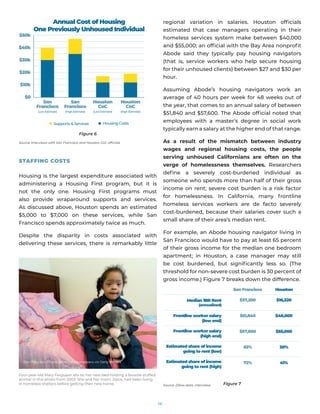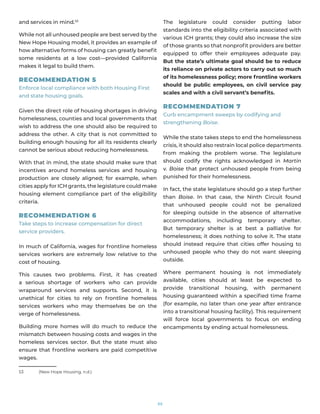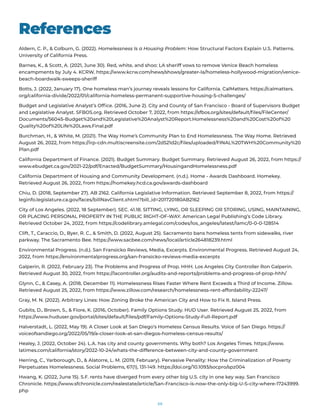This document discusses California's homelessness crisis and efforts to address it using the Housing First model. It finds that while California has invested billions in Housing First, homelessness has increased, unlike in Houston which has reduced homelessness by over 50% through more effective coordination and a greater housing supply. The document recommends California centralize coordination, permanently fund programs, reform zoning to increase housing, and enforce Housing First compliance to better emulate Houston's success.

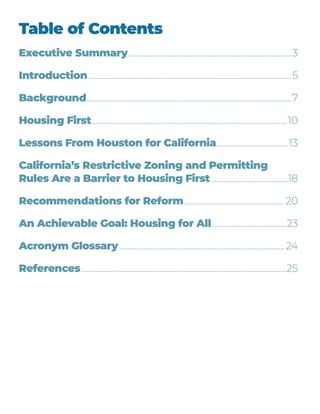

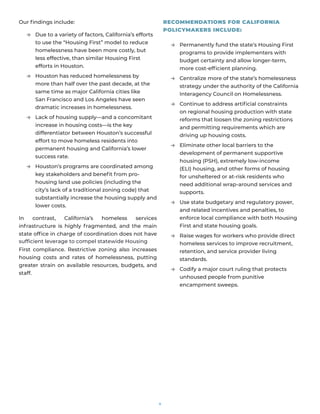


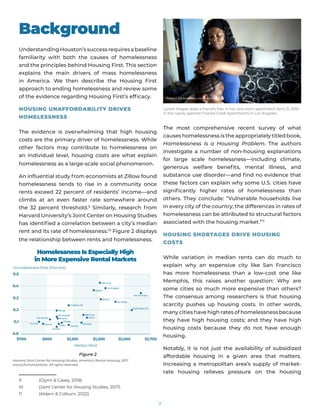

![9
individuals for violating quality of life laws.”17
The San
Francisco Coalition for the Homeless recently sued
the city for penalizing homelessness, including by
destroying personal property.18
Meanwhile, both Los Angeles and Sacramento have
passed encampment bans over the past year. The Los
Angeles ordinance expanded the city’s pre-existing
encampment ban to include “any street, sidewalk, or
other public property within 500 feet of a School or
Day Care Center.”19
Sacramento’s encampment ban
applies to sidewalks, business entrances, and the
American River Parkway.20
While enforcing encampment bans may temporarily
drive homelessness out of certain areas, it does
nothing to reduce homelessness itself. That is
because, as mentioned above, homelessness is
caused by a lack of housing; penalizing someone
for not being able to afford housing does nothing to
address the underlying problem.
In fact, research has found that criminalization can
worsen homelessness in the long run by making it
harder to get people housed.
A 2019 study of sweeps and citations in San Francisco
found that “anti-homeless ordinances play an
instrumentalroleincontributingtohomelessness”by
“systematically [limiting] homeless people’s access
to services, housing, and jobs, while damaging their
health, safety, and well-being.”21
For example, the
property destruction accompanying encampment
sweeps was found to sweep up important items like
prescription medication; it also caused significant
disruptions that made it harder for unhoused people
to access the services that might put them on a
trajectory toward being housed.
Inrecentyears,federalcourtshavecometorecognize
that some encampment bans violate the rights of
unhoused people. In Martin v. Boise, the Ninth Circuit
17 (Budget and Legislative Analyst’s Office, 2016)
18 (Moench, 2022)
19 (City of Los Angeles, 2022)
20 (Clift et al., 2022)
21 (Herring et al., 2019)
22 (Waskowicz, 2019)
23 (Wilson, 2022)
Court of Appeals ruled that unhoused people could
not be penalized for sleeping outside if they did
not have access to alternative accommodations.22
A
subsequent ruling reinforced this decision.23
MediaNews Group/Orange County Register via Getty Images
Mark Ligon sits in the doorway to his new apartment at The Orchard as
he watches officials celebrate the opening of the permanent supportive
housing complex for chronically homeless people in Santa Ana on
Thursday, Feb 1, 2018.](https://image.slidesharecdn.com/housing-abundance-as-a-condition-for-ending-homelessness-final-230512181710-f01599f8/85/Housing-First-9-320.jpg)
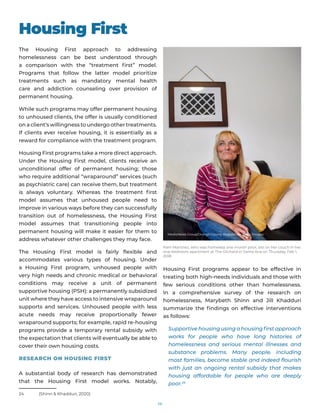
![11
Below, we briefly summarize two notable evaluations
of Housing First-style interventions.
THE FAMILY OPTIONS STUDY
One of the largest and most influential studies
of anti-homelessness interventions, the Family
Options Study observed more than 2,000 homeless
families over a period of three years. Participating
families were randomly provided with one of four
treatments: “usual care,” transitional housing, a
permanent housing subsidy, or a temporary rapid
re-housing subsidy.
Permanent subsidies—even without any additional
wraparound supports—were found to significantly
reduce a family’s likelihood of reentering the shelter
system. This, in turn, led to further positive outcomes.
In the words of the study’s authors: “Assignment to
the [permanent subsidies] intervention group more
than halved most forms of residential instability,
improved multiple measures of adult and child well-
being, and reduced food insecurity.”25
The Family Options Study supports Shinn and
Khadurri’s contention that ongoing rental subsidies
are all that is needed to help many families stabilize
in housing. (Incidentally, both Khadduri and Shinn
worked on the study.)
PERMANENT SUPPORTIVE HOUSING IN
SANTA CLARA
While the Family Options Study demonstrated that
rental subsidies could help some families exit from
homelessness, it had relatively little to say about
the most effective form of treatment for high-needs
individuals. A more recent study of PSH in Santa
Clara found that Housing First-style treatment could
also benefit individuals with serious behavioral
health conditions.
The study randomized 199 high-needs individuals
into a PSH treatment group and 224 individuals into
a control group. Despite their severe pre-existing
conditions, those who had been sorted into PSH were
able to remain housed for 93 percent of the three-
25 (Gubits et al., 2016)
26 (Raven et al., 2020)
27 (Nichols, 2021)
year follow-up period, on average. Additionally, use
of emergency psychiatric services declined among
the treatment group; utilization of outpatient mental
health and substance use treatment services rose.26
HOUSING FIRST IMPLEMENTATION IN
HOUSTON
Since 2012, the Houston area CoC has been
implementing an aggressive Housing First program,
overseen by the nonprofit Coalition for the Homeless
of Houston/Harris County. Although more than 100
organizations are involved in implementing the
homelessness response system—including local
governments, housing authorities, and various other
public and nonprofit entities—all relevant actors are
aligned around a set of core principles.
This is how Coalition president and CEO Mike Nichols
summarized the strategy in 2021:
We attribute our collective success to a number
of factors, among them: collaborative leadership
and buy-in among local elected officials and local
direct service provider agencies; a strong reliance
on good data to drive decision-making; and an
emphasis on prioritizing the most vulnerable for
access to those programs first. We follow Housing
First, a nationally recognized best practice that
involves providing housing to people with no
preconditions (e.g., sobriety) and then offering
voluntary supportive services to help them
maintain their housing.
Perhaps the most important key is our
community’s commitment to investing all
available homelessness resources toward
permanent housing with supportive services.
HUD defines permanent housing as “community-
based housing without a designated length of
stay in which formerly homeless individuals and
families live as independently as possible.”27
The Coalition makes use of various tools to secure
housing for the people it serves. While approximately
30 percent of the people served by Houston’s](https://image.slidesharecdn.com/housing-abundance-as-a-condition-for-ending-homelessness-final-230512181710-f01599f8/85/Housing-First-11-320.jpg)



![15
San Francisco’s most recent PIT report offers a
particularly dramatic illustration of this dynamic.
Based on its analysis of the 2022 PIT count and
other data, San Francisco’s HSH estimates that four
San Franciscans enter homelessness for every
individual who the department is able to place
in housing.42
Because of the city’s extraordinary
housing costs, its homeless services infrastructure
is unable to catch up with mushrooming
homelessness.
Not all California cities face the same pressures
as San Francisco. In recent years, Bakersfield and
Kern County have made substantial progress in
reducing chronic homelessness.43
But Bakersfield
is an exception that proves the general rule; as can
be seen in Figure 5, its rents are even lower than
those of Houston.
HOUSING FIRST IN BAKERSFIELD AND
KERN COUNTY
While relatively low housing costs are clearly a factor
in Kern County’s success at driving down chronic
homelessness, it is not the only factor. The Bakersfield
Kern County Homeless Collaborative, which acts as the
region’s CoC, has also pursued an aggressive Housing
First strategy.
The CoC adopted its first 10-year plan in 2008. In 2018,
it reported that it had successfully “[shifted] emphasis
from a shelter and transitional housing-based approach
that prepared homeless people for eventually being
housed, to a Housing First model focused on placing
them in housing with minimal delay, regardless of their
circumstances or pre-existing conditions. HUD CoC
Program and other public grants were redirected almost
entirely to the creation of new affordable permanent
housing opportunities, with supportive services focused
on helping people access and remain in housing.”
From 2008 to 2017, the CoC reports, it added more than
2,000 permanent housing beds—a more than sixfold
increase in the total number of permanent beds available
for the county’s unhoused population.44
42 (San Francisco Department of Homelessness and Supportive Housing, 2022)
43 (Kim, 2021)
44 (United Way of Kern County & The Kern County Homeless Collaborative, n.d.)
HOUSING PLACEMENT COSTS
In order to implement the Housing First model,
homeless services agencies must be capable of
meeting their clients’ need for housing. This may
involve developing publicly owned units, renting
unitsfromfor-profitlandlords,signingcontractswith
nonprofit housing providers, or some combination of
the above. All of these approaches cost money—and
their cost depends on the vagaries of the housing
market.
Houston’s CoC has been able to house more than
25,000 people in no small part because of the
region’s ample supply of subsidized and naturally
affordable housing. In interviews with California
YIMBY, officials at Coalition for the Homeless of
Houston/Harris County cited the local availability of
units that rent for less than $1,000 per month as a key
asset. Coalition officials estimated that the average
yearly cost of housing one of their clients is between
$17,000 and $19,000, with just $12,000 of that cost
going to housing and the rest to wraparound
services and supports.
In contrast, officials at HSH in San Francisco said
they must pay nearly three times as much to house
an individual for one year. The average yearly cost
in San Francisco is between $40,000 and $47,000,
of which between $30,000 and $35,000 goes to
housing alone. (See Figure 6 for more details.)
The price gap between Houston and San Francisco
when it comes to housing one homeless individual
closely tracks the gap in median rent between each
city—as seen in Figure 5, the median one bedroom
apartment in San Francisco rents for nearly three
times as much as the median one bedroom
apartment in Houston.
As a result, San Francisco must spend enormous
sums in order to acquire housing for its unhoused
population. And because the high prices in San
Francisco reflect an underlying shortage, even the
city’s current level of investment is not sufficient to
secure a unit for everyone who needs one.](https://image.slidesharecdn.com/housing-abundance-as-a-condition-for-ending-homelessness-final-230512181710-f01599f8/85/Housing-First-15-320.jpg)
